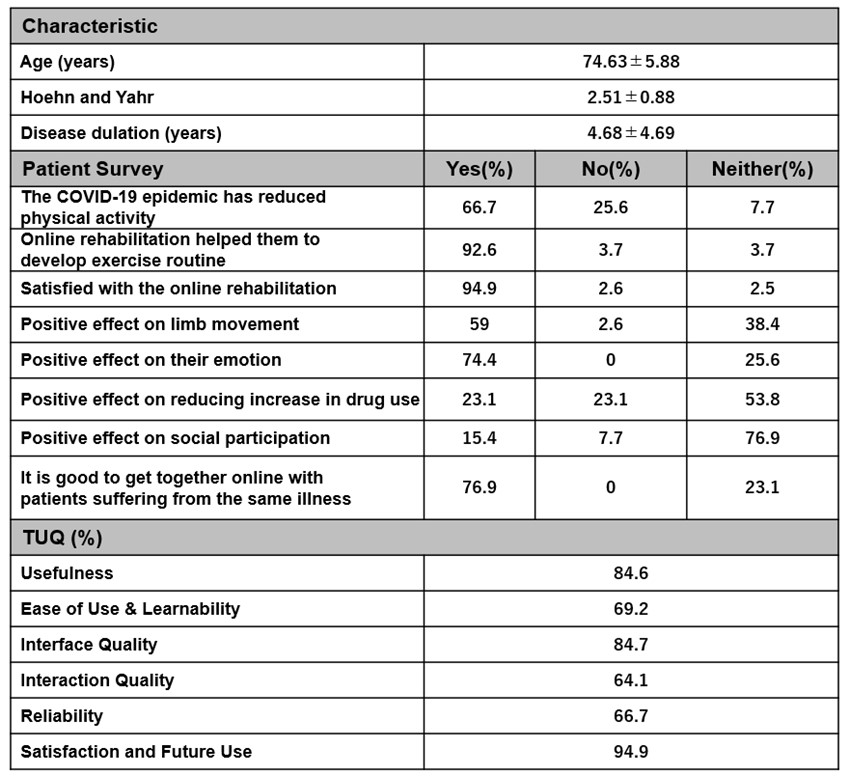Objective: The aim was to evaluate the effectiveness and utility of online rehabilitation program by conducting a survey using self-designed questionnaire, Parkinson’s Disease Questionnaire-39 (PDQ-39) and the Telehealth Usability Questionnaire (TUQ).
Background: Our previous study regarding the impact of COVID-19 pandemic on Parkinson’s disease (PD) patients revealed that they were troubled by decreased physical activity as well as missing the opportunity for undergoing rehabilitation. To address this issue, we started on an online rehabilitation program to encourage patients to develop exercise habits.
Method: Online rehabilitation program using ‘Zoom meetings’ (twice a week for 40 minutes per session) was offered to outpatient population with PD. During the program, pre-recorded rehabilitation content was shared and a physical therapist reviewed videos of participating patients and provided guidance as appropriate. Patients answered the questionnaires including self-designed questionnaire, PDQ-39 and TUQ at baseline and after 6 months of online rehabilitation program.
Results: Thirty-nine patients (mean age 74.6±5.9, disease duration 4.7±4.7 and HY stage 2.5±0.9) who had participated at least 10 times were included in the analysis. After 6 months, 94.9% were satisfied with the online rehabilitation and 92.6% reported that online rehabilitation helped them to develop exercise routine. In addition, 74.4% were aware of the positive effect on their emotion, and 76.9 answered it is good to get together online with patients suffering from the same illness. PDQ-39 showed improvement of 1 or more points in 14 of 39 patients. In those patients, the improvement was shown in the subdomain of Mobility, Stigmatization, Cognition, and Body Discomfort. On the TUQ, a high percentage of favorable responses were obtatined for “Usefulness” (84.6%), “Interface Quality” (84.7%), and “Satisfaction and Future use” (94.9%).[Table1]
Conclusion: Online rehabilitation is useful and satisfactory for Parkinson’s disease patients. There are, however, limitations in terms of ease of use, learnability, interaction quality, and reliability.
References: [1] Bambang Parmanto, Allen Nelson Lewis Jr, Kristin M Graham, Marnie H Bertolet. Development of the Telehealth Usability Questionnaire (TUQ). Int J Telerehabil. 2016 Jul 1;8(1):3-10. doi: 10.5195/ijt.2016.6196. eCollection 2016 Spring.
[2] Hyung-Youl Park, Young-Mi Kwon, Ha-Rin Jun, Seung-Eun Jung, Soon-Yong Kwon. Satisfaction Survey of Patients and Medical Staff for Telephone-Based Telemedicine During Hospital Closing Due to COVID-19 Transmission. Telemed J E Health. 2021 Jul;27(7):724-732. doi:10.1089/tmj.2020.0369.
[3] Tezuka T, Osada T, Terayama Y, Kubota M, Okusa S, Shiihashi G, Kubo SI, Suzuki N, Nakahara J, Seki M. The questionnaire survey regarding the impact of COVID-19 pandemic on Parkinson’s disease patients. Rinsho Shinkeigaku. 2022 Jan 28;62(1):8-14. doi: 10.5692/clinicalneurol.cn-001663.
To cite this abstract in AMA style:
S. Okusa, H. Saegusa, K. Miyakawa, Y. Tsutsumi, S. Ishida, K. Nishikata, T. Nukariya, T. Tezuka, Y. Nihei, Y. Kitagawa, S. Kubo, N. Suzuki, J. Nakahara, M. Seki. The effectiveness and usability of online rehabilitation for Parkinson’s Disease patients [abstract]. Mov Disord. 2023; 38 (suppl 1). https://www.mdsabstracts.org/abstract/the-effectiveness-and-usability-of-online-rehabilitation-for-parkinsons-disease-patients/. Accessed December 28, 2025.« Back to 2023 International Congress
MDS Abstracts - https://www.mdsabstracts.org/abstract/the-effectiveness-and-usability-of-online-rehabilitation-for-parkinsons-disease-patients/

